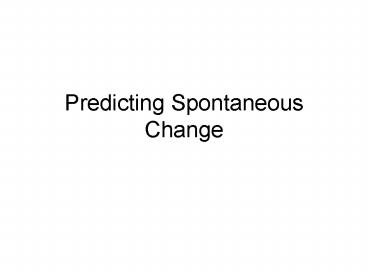Predicting Spontaneous Change - PowerPoint PPT Presentation
1 / 16
Title: Predicting Spontaneous Change
1
Predicting Spontaneous Change
2
Spontaneous Change
- One that occurs by itself under specified
conditions, without an ONGOING input of energy - Burning wood
- Freezing water at -1 ?C
- Cup breaking
- If a reaction (at a specific temperature and
pressure) is spontaneous in one direction, it is
NOT spontaneous in the opposite.
3
Spontaneous Reactions
- Spontaneity has nothing to do with time
4
Diamond vs. Graphite
diamond
graphite
5
How Does Spontaneity Relate to Chemical
Equilibria?
- Consider a reaction (it is balanced)
- A(g) B(g) C(g)
K 10 - If you start a reaction with
- AB 1 M and C 7 M
- Which way will the reaction shift to get to
equilibrium?
6
How Does Spontaneity Relate to Energy and Heat?
- Consider the reaction shown below
- H2O(l) H2O(g) ?H
-44.0 kJ
The sign of ?H alone cant predict spontaneity!!
7
Must Be Something Else Involved
- One feature that ALL spontaneous processes share
is an increase in the degree of freedom or
disorder of the universe (system surroundings) - ENTROPY (S)
- Solid ? liquid ? gas ?Sgt0
- Salt liquid ? ions in solution ?Sgt0
- A(g) B(g) C(g)
?Sgt0 - ?Sgt0, Entropy is increasing.
8
Predicting the SIGN of ?S
- Temperature
- Increase temperature, ?Sgt0 (increase in
entropy) - Phase Change
- ?Sgt0 (increases) from solid?liquid?gas
- Usually ?Sgt0 (increases), when dissolving a
solid in a liquid. - ?Slt0 (decreases), when dissolving a gas in a
liquid. - Size and Complexity
- In general, ?Sgt0 (increases) with increasing
size and complexity for substances of the same
phase.
9
Comparison of the entropy of solids, liquids and
gases
10
Entropy decreases when a gas is dissolved in a
liquid.
?S(O2(g)) 205.0 J/mol?K
?S(O2(aq)) 110.9 J/mol?K
11
Entropy increases with increasing molecular
complexity.
?S 211 J/mol?K
240 J/mol?K
304 J/mol?K
12
2nd Law of Thermodynamics
- Entropy is always increasing for spontaneous
reactions - ?Suniv ?Ssys ?Ssurr gt 0
- Calculating ?S is just like calculating ?H
- ?Srxn SnSproducts SnSreactants
- Appendix B has the ?S values
- Problems 20.33, 20.35, 20.37, 20.39
13
Gibbs Free Energy
- Way to relate ?H and ?S
- ?G ?H-T?S
- ?G is called Gibbs Free Energy
- Measure of the spontaneity of a reaction
- ?Glt0 reaction is spontaneous
- ?Ggt0 reaction is nonspontaneous
- ?G0 reaction is at equililbrium
14
Spontaneity, or the sign of ?G, depends on sign
?H, ?S and sometimes the temperature of the
system.
15
Free Energy and Equilibria
- Gibbs Free Energy is related to K
- ?G -RT ln K
16
Pop Quiz 10 Part A.
At ordinary pressure, water freezes below 273 K
and melts above 273 K. Explain how both of
these reactions can be spontaneous. Specifically,
what are the qualitative values (, -, 0) of ?H
and ?S for each reactions below? H20 (s) ? H20
(l) above 273 K ?H _____ ?S ______ -T
?S______ ?G______ H20 (l) ? H20 (s) below
273 K ?H _____ ?S ______ -T ?S______
?G______































